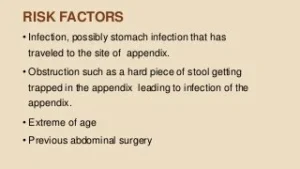What the right side pain in lower abdomen indicate?
The pain is an indicator which show that there is something wrong in our body. The pain in that region is due to running direct after meal or may be due to infection in the right side of lower abdomen is an indicator of appendicitis. Appendix is an hollow vestigial organ) have no function in the human body but, if get inflamed cause severe pain in right side of abdomen.
What is Appendicitis?
Appendicitis is an inflammation of the appendix,(a finger-shaped pouch) cause by any pathogens most commonly bacteria, that projects from your colon on the lower right side of your abdomen.
Appendicitis causes pain in your lower right abdomen. However, in most people, pain begins around the navel and then moves. As inflammation worsens, appendicitis pain typically increases and eventually becomes severe. Due to its variable position it’s pain feel like radiating pain , as appendicitis progress it gradually increase in pain and eventually become severe and unable person to walk.

Types of Appendicitis
There are two types of appendicitis.
Acute appendicitis
Acute appendicitis is a severe and sudden case of appendicitis. It’s most common in children and young adults between the ages 10 and 30 years old and occurs more frequently in males than females. Pain tends to develop and intensify quickly over the course of 24 hours.
If not treated immediately it can lead to rupture of appendix.
Chronic appendicitis
Chronic appendicitis is less common than acute appendicitis. It occurs in only about 1.5 percent of all people who have already had a case of chronic appendicitis. In chronic cases of appendicitis, the symptoms may be relatively mild and are thought to usually occur following a case of acute appendicitis. Symptoms may disappear before reappearing again over a period of weeks, months, or even years.
What are the symptoms show by patient suffer from Appendicitis?
The appendicitis person show several symptoms
- Sudden pain on right side of lower abdomen region.
- Sudden pain in naval region or it shift to right abdomen region.
- Pain worsen with coughing, sneezing, walking.
- Nausea.
- No desire for hunger.
- Low grade fever (99°F).
- Constipation or diarrhea.
- Vomiting.
- Abdominal bloating.

When to see a doctor:
Make an appointment with a doctor if you or your child has severe signs or symptoms. Severe abdominal pain requires immediate medical attention.
What are the causes of appendicitis?
Appendicitis may cause due to following reasons
- Blockage of cell lining of appendix due to which inflammation cause.
- The bacteria present here are rapidly divide and swallowing and inflammation cause.
- Run direct after having meal.
- Use of spicy food.

What are the risk factor for Appendicitis?
The risk factor for appendicitis are
Age:
It occurs in any age but most involved are 10 to 30 year old person.
Sex:
It is more common in males than female.
Family history:
Child how’s parents have appendicitis are high risk of developing it.

What are the complications of appendicitis?
If appendicitis are not treated it can cause severe complications include
- Rupture to appendix as it fill with death cell or bacteria so due to rupture of appendix it cause life threading situation as it affects the surrounding area.
- If your appendix is rupture a pocket of infection is form. It progressive increased and may cause development of cancerous cell.
How to diagnose appendicitis?
Doctor can diagnose appendicitis by first taking history by asking questions about this. After determine the sign and symptoms the doctor will do abdominal examination .
- Physical exam to assess your pain. Your doctor may apply gentle pressure on the painful area. When the pressure is suddenly released, appendicitis pain will often feel worse, signaling that the adjacent covering of abdomen is inflamed. Your doctor may also look for abdominal rigidity and a tendency for you to stiffen your abdominal muscles in response to pressure over the inflamed appendix. Your doctor may use a lubricated, gloved finger to examine your lower rectum (digital rectal exam). Women of childbearing age may be given a pelvic exam to check for possible gynecological problems that could be causing the pain.
- Blood test. This allows your doctor to check for a high white blood cell count, which may indicate an infection.
- Urine test. Your doctor may want you to have a urinalysis to make sure that a urinary tract infection or a kidney stone isn’t causing your pain.
- Imaging tests. Your doctor may also recommend an abdominal X-ray, an abdominal ultrasound, computerized tomography (CT) scan or magnetic resonance imaging (MRI) to help confirm appendicitis or find other causes for your pain.
How to treat appendicitis?
Appendicitis can be treated by surgical procedures
Surgery to remove the appendix (appendectomy)
Appendectomy can be performed as open surgery using one abdominal incision about 2 to 4 inches (5 to 10 centimeters) long. Or the surgery can be done through a few small abdominal incisions (laparoscopic surgery). During a laparoscopic appendectomy, the surgeon inserts special surgical tools and a video camera into your abdomen to remove your appendix. In general, laparoscopic surgery allows you to recover faster and heal with less pain and scarring. It may be better for older adults and people with obesity. But laparoscopic surgery isn’t appropriate for everyone. If your appendix has ruptured and infection has spread beyond the appendix or you have an abscess, you may need an open appendectomy, which allows your surgeon to clean the abdominal cavity. Expect to spend one or two days in the hospital after your appendectomy.

How Appendicitis can prevent?
There’s no way to prevent appendicitis. But it may be less common in people who eat foods high in fiber, such as fresh fruits and vegetables.
Author


